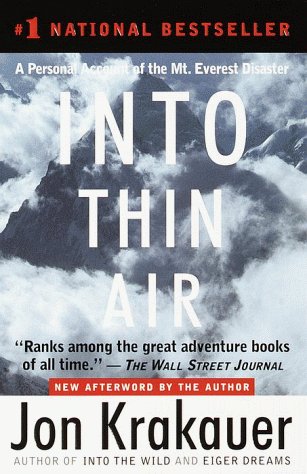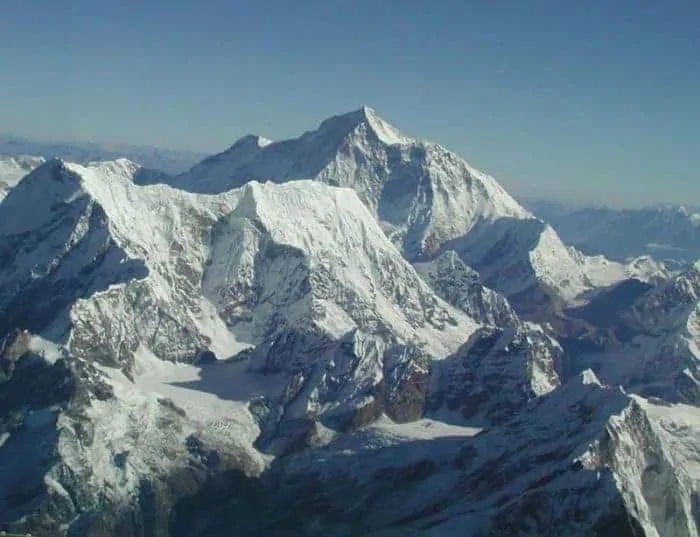 There are books you read. And then there are pulse-pounding books you experience. Jon Krakauer’s non-fiction Into Thin Air (1996) definitely falls into the latter. It is a relentless, mind numbing, superb account of an innocent journalistic mission turned disaster. I was riveted from the opening praise (“Every once in a while a work of nonfiction comes along that’s as good as anything a novelist could make up . . . Into Thin Air fits the bill.” – Forbes) to the harrowing last page where Yasuko, at 47, the oldest women to successfully reach the peak of Everest is left to die just below the summit, clinging to a fellow climber during her last gasps of life, never to return to share the joy of her historic achievement.
There are books you read. And then there are pulse-pounding books you experience. Jon Krakauer’s non-fiction Into Thin Air (1996) definitely falls into the latter. It is a relentless, mind numbing, superb account of an innocent journalistic mission turned disaster. I was riveted from the opening praise (“Every once in a while a work of nonfiction comes along that’s as good as anything a novelist could make up . . . Into Thin Air fits the bill.” – Forbes) to the harrowing last page where Yasuko, at 47, the oldest women to successfully reach the peak of Everest is left to die just below the summit, clinging to a fellow climber during her last gasps of life, never to return to share the joy of her historic achievement.
By now, Into Thin Air, has been widely acclaimed having received its share of awards including a Pulitzer nomination in 1998 for best non-fiction. Fortunately for my 40th birthday last year my parents gave me a copy of this book, declaring it a must read with inspiration that would drive me to future “summits” in my life. As I alternated between it and a book on Ayn Rand’s objectivism, I easily found Krakauer’s story winning me over with its clever narrative mix of journalistic reporting, first hand accounts, and colorful historical perspective.
This is the story of heroism, poor decision making, human survival and death, and dealing with the aftermath of what is now Mount Everest’s second worst tragedy on record. In 1996 Jon Krakauer, a journalist and author of Into The Wild also a best-seller, agreed to write a story on the commercialization of Everest for Outdoor magazine. Originally he was to spend time only at base camp while expedition members made the trek. However, as we quickly learn Krakauer is also a thrill seeker and avid mountaineer and it doesn’t take long, to his wife’s chagrin, that he too is ascending the mountain. What follows is an engrossing account of the characters and personality types that seek the ultimate climb, and some of the insights into their motivations. I was pleased that the book never delved too far into the technicalities of climbing itself, but rather focused on the human interest elements including not only the climbers themselves, but also the mysterious culture of the Nepalese and the Sherpas who have become essential to any Everest expedition.
I’ve never climbed myself nor had the interest, but I still found each page full of compelling drama and facts. I learned that base camp alone was over 17,000 feet above sea level. And that climbing the mountain requires weeks, usually months, of acclimatization and shorter practice runs to adjust the hearts, lungs and blood to what amounts to virtually unlivable conditions. Helicopter rescues are challenging, if not impossible at certain altitudes because the air is not dense enough to provide adequate lift. Also interesting is the business of Everest and how a once elite experience with few climbers ever summiting since Sir Hillary Edmund’s historic first climb in 1953, has transformed into a Disney of sorts where any semi-conditioned perp with $65,000 and some spare time can make the trek (maybe the ultimate reality show is next… “Celebrity Everest!”). Over time, some believe that Everest has lost its mystique now that hundreds have made it to the top. With paved roads, hundreds of Sherpas providing expert assistance throughout, and modern communication and mountaineering equipment it indeed appears the innocent days are long gone. But in my view, it’s all part of human curiosity and like ants we swarm mother earth in search of every adventure and discovery no matter at the bottom of the sea, the peak of Everest, or the outreach of space.
At the heart of the true story are the two expedition leaders, Rob Hall (New Zealand) and Scott Fischer (US). Both have tremendous climbing experience and both have turned their craft into climb businesses, charging clients a fee to be escorted to the top. Neither suspected that May 10 day would be their last, but I’m sure agreeable that if their time would come, it would be to their life-long obsession.
Krakauer begins his adventure at base camp and over a period of a few months works his way up along with his team to advanced base camp (ABC), and then a series of four camps that ultimately wind their way to the summit. Along the way, we learn how difficult it is just to breath – oxygen levels are 50% of normal at base camp, and only about 33% at the top. This challenge alone requires a completely different mind set to surviving the simplest of tasks, and also means bottled oxygen is a necessity for all but the most strident climber. No matter how physically strong or mentally prepared, a climber can face many potentially fatal outcomes including expansion of the brain, increased heart attack risk, and hallucinations that can lead to a variety of altitude sicknesses. At best, depleted oxygen results in the motor skills of a small child, and a need for the body to begin to consume itself resulting in severe weight loss and potential starvation.
The first part of the book examines the people, the culture and some history of Everest and the back-story of Krakauer’s Outdoor magazine sponsored trip. The second part focuses on the climb itself, the logistics of staging such an effort, and some of the decisions made that come back to haunt the expedition. The last part documents the disaster, where upon reaching the summit, an unplanned storm blows in and throws the teams into every-man-for-himself, chaotic disarray. This is where we also learn that often getting down, not up, the mountain is usually the riskier proposition. Many climbers expend every ounce of energy in a moment of “summit fever” on their final push to fulfill a lifelong dream of reaching the highest point on earth. Once on top, however, the realization can strike that bottled oxygen levels are dangerously low or non-existent, and that daylight is fading. Being without oxygen and daylight can almost guarantee a fatal outcome. The path to the top of Everest is testament to this daunting fact with frozen, half-buried corpses littering the way.
Towards the climax of the book, the pace is frantic as climbers caught in the storm lose their way, panic, and make decisions that will cost some their lives. Krakauer, a strong climber himself, miraculously finds his way back to base camp amid much confusion, mistaken identities, and swirling winds that limit visibility to virtually zero. Compound this with temperatures below 40, and it’s easy to understand how a sunny Everest peak can almost instantly transform into a death trap.
After the shocking reality of that fateful May 10 day sets in, with 6 dead, and others in critical condition, many requiring amputation of limbs, fingers (and in one case, nose) due to frostbite, Krakauer begins to attempt to comprehend what has happened and why it came to be. A true outdoorsman, his only reaction upon returning to a hotel room in Kathmandu was to roll two joints, lie naked on his bed and cry. His own Apocalypse Now.
In an interesting postscript, the author rebuts allegations made by another climber on the hill that day, a Russian called Boukreev, that questioned the accuracy of Krakauer’s description of the events during the fateful final hours at the summit. At the center of the controversy was whether Boukreev, as a guide, had abandonded the safety of his paying clients by rushing down the mountain ahead of them once disaster struck. Boukreev strongly denies wrong doing. But I find Krakauer’s journalistic approach to be the more believable, especially when you consider he admits (possibly wrongfully, influenced by survivor’s guilt) that some of his decisions may have led to the deaths of some of his fellow climbers.
That the drama continues to unfold to this day about what really happened that day in 1996 up high in the Himalayan mountains demonstrates the degree of passion and sorrow that continues to envelope all who were there that day.
Stark Insider Book Review
by Jon Krakauer
333 pages, 19984.5 out of 5 stars
Here is some more information I have found courtesy of Google that may be of interest to those keen on learning more about Everest, Krakauer, and some of the survivors:
- A link to the original Outdoor magazine article by Jon Krakauer that generated tremendous interest and controversy, ultimately driving him to write the book
- Biography of Jon Krakauer from Wikipedia
- Into The Wild by Jon Krakauer – next on my list of must reads
- Discovery Channel “Everest: Beyond the Limit” multi-part series on Everest
- A 2001 survivor interview by Mountainzone with Beck Weathers (who had his hands and part of his nose amputated due to severe frostbite)
- More views on the events including some of the guides in addition to Krakauer and Boukreev
- A Salon article on Sandy Pittman, the controversial “socialite” that allegedly paid her way to the top of Everest only to be rescued from certain death



